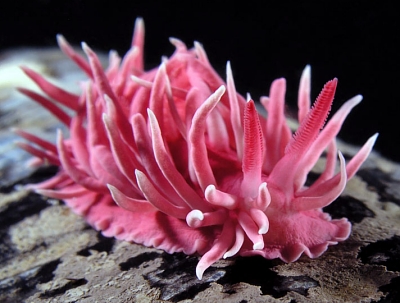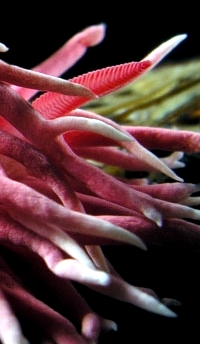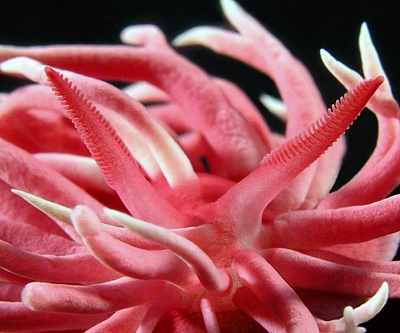Photos of Okenia rosacea - Hopkins' Rose
February 5, 2007
From: Kevin Lee

Hi Doc,
The rhinophores and the gills of Okenia rosacea are notoriously difficult to capture as this nudibranch is oft covered with a dense forest of long, like-colored cerata, which camouflage them.
Finally, after a two-hour+ dive, I managed to get some decent fotos of these organs (two individuals) and am pleased to share the attached images.
Also in the second photo some of the cerata seems to be "forked" or has branched into two parts [see close-up]. Was wondering if this is an anomaly or a common occurrence.
Locality: Shaw's Cove, Lagnuna Beach, 20 feet, Califonria, USA, Eastern Pacific, 20 January 2007, Found on mussel shells, between rocky reef walls (Shaw's swim-through). Length: approx. 3/4 inch. Photographer: Kevin Lee.
Best wishes,
K:-)
diverkevin@gmail.com



Hi Kevin,
Gorgeous photos. Yes the gills and rhinophores are often difficult to see, leading to many identifying this species as an aeolid nudibranch. Once you see the typical dorid gill plume it is quite obvious.
Now for a nomenclature review. We don't usually use the term 'cerata' for cerata-like structures in dorid nudibranchs. We usually refer to them as 'dorsal papillae'. To be very precise, cerata is usually restricted to the aeolid nudibranchs, where they carry a branch of the liver diverticulum up into their tips. However the term 'cerata' has become widely used for cerata-like structures in many opisthobranchs including the sacoglossans and some non-dorid nudibranchs. Like wings, which have evolved independently in birds, insects, bats etc, not all 'cerata' are the same
The branched papillae in your photo are curious. Anomalies happen. Good observation however. In your close-up of the head, we can clearly see the detail of the rhinophores and even count the 28 lamellae.
Although I really disdain common names, this is one that is special to those of us on this coast. Originally described in the genus, Hopkinsia, referring to Hopkins Marine Station in Monterey, California, where the describer, Dr. Frank Mace MacFarland worked for many of his very productive years. While the nudibranch name is now placed in Okenia where it systematically belongs, another species still carries reference to the marine lab. That species is the the xanthophyll produced by the nudibranch, named Hopkinsiaxanthin, that gives it it's bright pink color.
Thanks for sharing,
Dave Behrens
Related messages
-
Re: Okenia rosacea - feeding & breeding
From: Phil Garner, September 5, 2006 -
Re: Okenia rosacea - feeding & breeding
From: Kevin Lee, December 15, 2005 -
Re: Okenia rosacea - feeding & breeding
From: Jeff Goddard, December 14, 2005 -
Okenia rosacea - feeding & breeding
From: Kevin Lee, December 13, 2005 -
Okenia rosacea or Hopkins Rose
From: Michael Jimenez, December 6, 2005 -
Many new species of Okenia
From: Bill Rudman, December 21, 2004 -
Hopkinsinia rosacea from Catalina Island, CA
From: James Lyle, February 27, 2004 -
Hopkinsia rosacea - food
From: Alan Grant, February 19, 2002 -
Information on Hopkinsia rosacea
From: Sarah Heinemann, January 30, 2002 -
Hopkinsia rosacea from Shaw's Cove
From: Bruce Wight, January 30, 2002 -
Photos of Hopkinsia rosacea
From: Bruce Wight, June 28, 2000 -
A photo of Hopkinsia rosacea
From: Dave Behrens, May 4, 2000 -
Hopkinsia rosacea
From: Juniscilla, May 3, 2000
